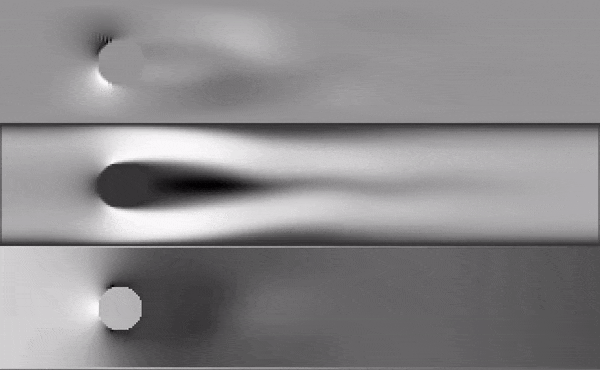karman_taichi is an incompressible fluid solver written in the Taichi programming language. It solves a 2-D rectagular fluid field with a cylindrical obstacle. A Karman vortext street can be observed when the Reynolds number is sufficiently large.
In the following example, the animation is showing the y-direction velocity, x-direction velocity and the pressure field, respectively from top to bottom. The Reynolds number in this example is around 150. (The characteristic length used in Reynolds number should be the diameter of the cylinder, not the width of the channel.)
I used the finite volume method (FVM) to represent the Navier-Stokes equation. The Semi-Implicit Method for Pressure Linked Equations (SIMPLE) was used to solve the velocity and pressure field iteratively.
The main loop of the solver is simply a implementation of what's described as the SIMPLE method.
Under construction...
-
Grid of high resolution is NOT required to be able to see the vortex. I found that even on very coarse mesh, Karman vortex can occur and develop. In the example above, I have 64 cells in the y direction and 320 cells in the x direction (Even this is probably more than enough).
-
You do NOT need very fine, adaptive boundary layer to generate the vortex. I have no adaptive mesh layer in my simulation. In fact, the cylinder itself is approximated by square cells.
-
Be careful with your discretization scheme for the convection term in the momentum equation. Some numerical schemes, for example, the first order upwind scheme, have strong numerical viscosity and can suppress the vortex street. Simple mid-point scheme was used in this solver.
-
GPU didn't work on my old Thinkpad W530 laptop. Feel free to try my code if you have CUDA capable PC!
-
BiCGSTAB was used in my solver to solve both the momentum equation and the pressure correction equation. While BiCGSTAB is stable and fast on itself, lack of pre-conditioner and multigrid led to very slow computation speed (Every frame will take 5-10 minutes to compute!)
-
Abstraction level of the code is very limited. Especially the handling of boundary condition is ugly and clumsy.
-
Much more ...
